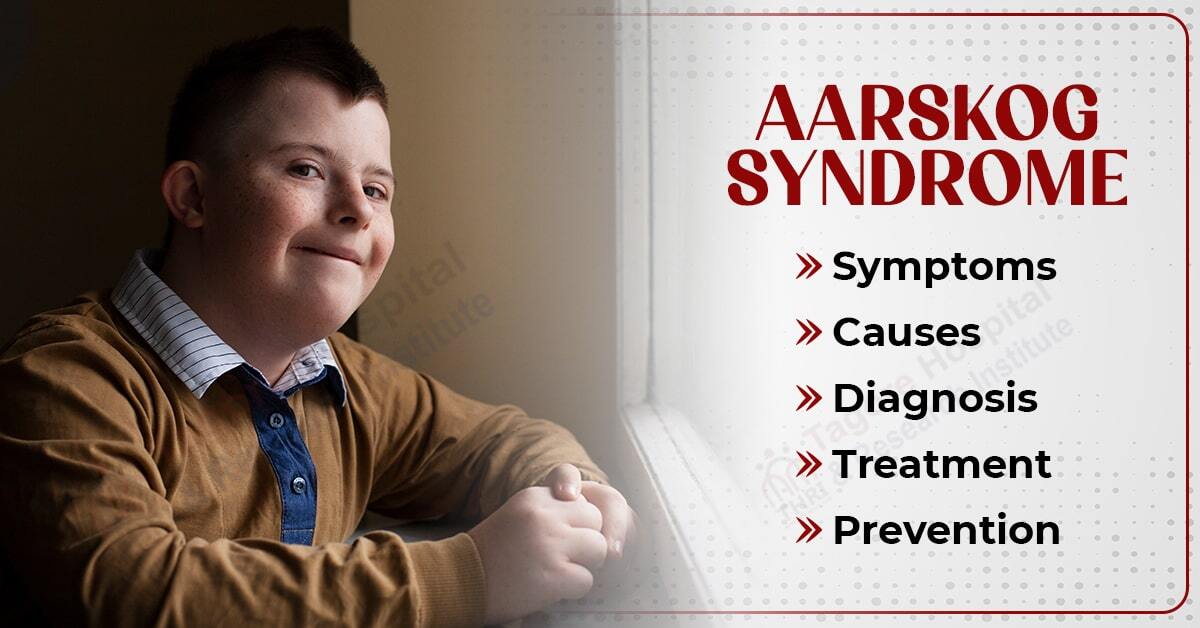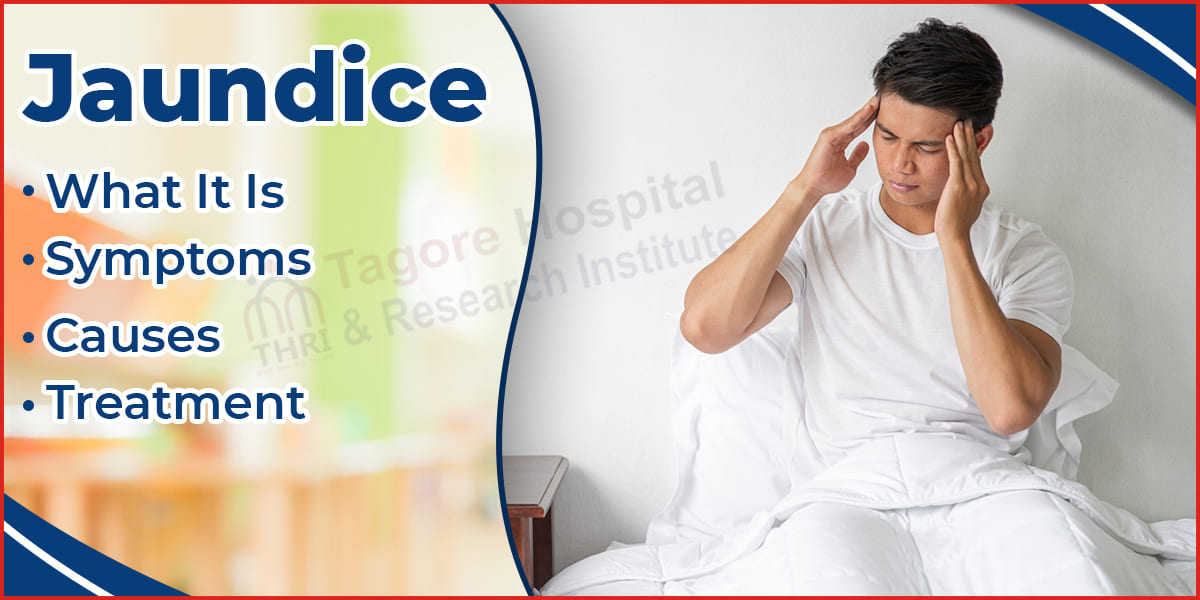- By Tagore Admin
- Posted November 15, 2023
Overview
A rare genetic disorder that is inherited and affects the skeleton, genitalia, muscles, stature, and general appearance is called Aarskog syndrome. The main areas that are usually impacted are the face, fingers, and toes.
This syndrome primarily affects men, though there have been a few reports of female cases as well. Growth inhibition is a known feature of Aarskog syndrome, which may not be detected until the child is three years old.
Symptoms of Aarskog Syndrome
Aarskog-Scott syndrome, also known as Aarskog syndrome (AS), is a rare genetic disorder that primarily affects males. It is characterized by facial, skeletal, and genital abnormalities, and its severity can vary widely among affected individuals. Here are some common symptoms associated with Aarskog syndrome:
Facial Features:
● Widely spaced eyes (hypertelorism)
● Short nose with a broad tip
● Anteverted nostrils (nostrils that open forward)
● Prominent upper lip (philtrum)
Skeletal Abnormalities:
● Short stature
● Abnormalities of the fingers and toes, such as short fingers (brachydactyly) and clinodactyly (inward curvature of the fifth fingers)
● Joint hypermobility
● Mild joint and muscle problems
Genital Abnormalities:
● In some cases, individuals with Aarskog syndrome may have undescended testicles (cryptorchidism).
Developmental Delays:
● Speech and language delays may be present.
● Some individuals may have mild intellectual disability.
Other Features:
● Abnormalities of the skin, such as redundant skin folds and a widow's peak hairline.
● Inguinal hernias (protrusion of part of the intestine through the abdominal wall)
● Umbilical hernias (protrusion of part of the intestine through the abdominal wall near the navel)
Causes of Aarskog Syndrome
Aarskog syndrome is primarily caused by mutations in the FGD1 gene located on the X chromosome. This gene provides instructions for making a protein that plays a role in the development and maintenance of various tissues in the body.
Aarskog syndrome follows an X-linked recessive inheritance pattern. This means that the FGD1 gene is located on the X chromosome, and males have only one X chromosome (XY), while females have two X chromosomes (XX).
If a male inherits a mutated copy of the FGD1 gene from his mother, who carries the mutation on one of her X chromosomes, he will likely develop Aarskog syndrome because he has only one X chromosome. Females with one copy of the mutated gene are typically carriers and may not show symptoms, as they have another normal X chromosome.
The FGD1 gene provides instructions for producing a protein called faciogenital dysplasia 1 protein, which regulates cell division, cell movement, and the formation of various tissues during development. Mutations in this gene can disrupt normal development, leading to the characteristic features of Aarskog syndrome.
It's important to note that the severity of Aarskog syndrome can vary, even among individuals with the same mutation. Other factors, including genetic and environmental influences, can contribute to the variability in symptoms.
If Aarskog syndrome is suspected based on clinical features, genetic testing can be conducted to identify mutations in the FGD1 gene. A genetic counselor can provide information about the inheritance pattern, assess the risk of recurrence in families, and help individuals and families understand the implications of the genetic findings.
You Can Read Also:- Anorexia Nervosa: Symptoms, Causes, Risk Factors, Diagnosis and Treatments
Diagnosis of Aarskog Syndrome
The diagnosis of Aarskog syndrome involves a combination of clinical evaluation, medical history assessment, and genetic testing.
1. Clinical Evaluation:
● A healthcare professional, often a clinical geneticist or a pediatrician, will assess the individual's physical features and developmental milestones. Distinctive facial, skeletal, and genital features characterize Aarskog syndrome.
● Common facial features include widely spaced eyes (hypertelorism), a short nose with a broad tip, and a prominent upper lip.
2. Medical History:
● A thorough medical history is taken to identify any developmental delays, intellectual disabilities, or other associated health issues.
● Information about the family history may also be collected to determine if there is a pattern of Aarskog syndrome or related conditions.
3. Genetic Testing:
● Molecular genetic testing is typically performed to confirm the diagnosis of Aarskog syndrome. This involves analyzing the FGD1 gene for mutations.
● Genetic testing may be done through various methods, such as DNA sequencing, to identify changes or mutations in the gene.
4. Chromosome Analysis:
● In some cases, a karyotype analysis may be performed to examine the structure and number of chromosomes. This can help identify any abnormalities in the sex chromosomes, particularly in males.
5. X-rays and Imaging Studies:
● X-rays or other imaging studies may be conducted to assess skeletal abnormalities or other physical features associated with Aarskog syndrome.
6. Consultation with Specialists:
● Depending on the specific symptoms and features observed, individuals with Aarskog syndrome may be referred to specialists for further evaluation and management. This may include consultations with orthopedic surgeons, urologists, speech therapists, and other healthcare professionals.
You can read also:- Agoraphobia: Types, Causes, Symptoms, Risk Factors and Treatment
Treatment of Aarskog Syndrome
The treatment of Aarskog syndrome is typically tailored to address specific symptoms and needs of the individual. Since Aarskog syndrome is a genetic disorder, there is no cure, but various interventions can help manage the associated features and improve quality of life. Here are some aspects of treatment and management:
1. Multidisciplinary Approach:
Individuals with Aarskog syndrome benefit from a multidisciplinary treatment approach, involving a team of healthcare professionals such as geneticists, pediatricians, orthopedic surgeons, urologists, and speech therapists. This collaborative effort aims to address the diverse range of symptoms associated with the condition and tailor interventions to the specific needs of each individual.
2. Surgical Interventions:
Surgical procedures may be considered to address physical abnormalities associated with Aarskog syndrome. This can include corrective surgeries for hand and finger abnormalities, as well as procedures to manage conditions like inguinal hernias or undescended testicles. Orthopedic interventions may be necessary for musculoskeletal issues.
3. Speech and Language Therapy:
Many individuals with Aarskog syndrome may experience speech and language delays. Speech therapy can be an essential component of treatment, helping individuals improve communication skills, articulate speech sounds, and overcome any challenges in language development.
4. Supportive Therapies:
Supportive therapies are often employed to enhance the overall quality of life for individuals with Aarskog syndrome. These may include physical therapy to address joint and muscle problems, occupational therapy to improve fine motor skills, and educational support to accommodate learning or developmental delays.
5. Genetic Counseling:
Genetic counseling is crucial for individuals and families affected by Aarskog syndrome. Genetic counselors provide information about the genetic basis of the condition, discuss inheritance patterns, and assist in family planning decisions. Understanding the genetic aspects of the syndrome can help families make informed choices about the risk of recurrence.
6. Regular Monitoring and Follow-Up:
Given the variability in the severity of symptoms, regular medical check-ups and monitoring are essential for individuals with Aarskog syndrome. This allows healthcare professionals to track growth, development, and any emerging health issues, enabling timely interventions and adjustments to the treatment plan as needed.
Prevention of Aarskog Syndrome
Aarskog syndrome is a genetic disorder, and prevention involves genetic counseling and testing. To prevent Aarskog syndrome, however, one must make educated reproductive choices to lower the likelihood of passing on the condition to subsequent generations, rather than trying to modify the condition in an affected individual.
● Genetic Counseling: Genetic counseling helps individuals and couples understand the genetic basis of Aarskog syndrome, assess the risk of having a child with the condition, and make informed decisions about family planning.
● Carrier Screening: Carrier screening is a genetic test that can identify individuals who carry a single copy of a gene mutation associated with Aarskog syndrome. Knowing carrier status is crucial for making informed reproductive decisions.
● Prenatal Diagnosis: For couples at risk of having a child with Aarskog syndrome, prenatal testing, such as chorionic villus sampling (CVS) or amniocentesis, can be considered to diagnose the condition in the fetus during pregnancy.
● In Vitro Fertilization (IVF) with Preimplantation Genetic Testing (PGT): Couples undergoing IVF may choose to undergo preimplantation genetic testing to screen embryos for Aarskog syndrome before implantation. This can help select embryos without the genetic mutation for implantation.
Tags





